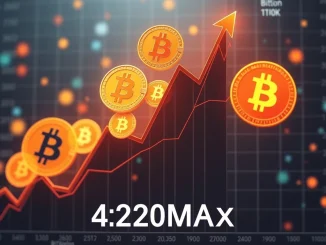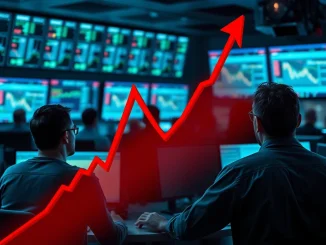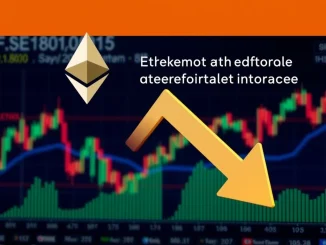
Hold onto your hats, folks! While the crypto world is known for its rollercoaster rides, traditional markets are also feeling the tremors. A recent report circulating on X (formerly Twitter) from WhaleWire’s Jacob King is causing quite a stir: the U.S. stock market has reportedly plummeted by a staggering $9.6 trillion since Donald Trump’s return to office. That’s a number that’s hard to even fathom! For those of us navigating the volatile crypto seas, understanding the currents in the broader financial ocean is crucial. Let’s dive into what this stock market decline means and what could be driving this massive shift.
Decoding the $9.6 Trillion Stock Market Decline: What’s Really Happening?
A $9.6 trillion loss is not just pocket change; it’s a monumental figure that signals significant shifts in investor sentiment and economic realities. But before we jump to conclusions, let’s break down what this US stock market downturn could signify:
- Economic Headwinds: Are we facing stronger economic headwinds than anticipated? Factors like inflation, rising interest rates, and global uncertainties can significantly dampen investor enthusiasm.
- Policy Concerns: Market reactions are often tied to policy shifts and political landscapes. Changes in government policies or perceived instability can lead to market jitters and sell-offs.
- Correction or Crisis?: Is this a healthy market correction, a necessary pullback after a period of growth, or are we staring down the barrel of a deeper economic crisis? The scale of the decline certainly raises eyebrows.
- Data Source and Context: It’s crucial to examine the data source and the timeframe precisely. “Since Trump returned to office” needs specific dates for accurate analysis. We need to understand the baseline and the period over which this decline is measured.
Understanding Market Volatility: The New Normal?
Market volatility has become a buzzword in both crypto and traditional finance. But what does it truly mean, and why is it relevant now?
Volatility essentially measures how much the price of an asset fluctuates over time. High volatility means prices can swing dramatically in short periods, creating both opportunities and risks. Several factors contribute to increased market volatility:
- Geopolitical Instability: Global events, conflicts, and political tensions inject uncertainty into markets, leading to rapid shifts in investor sentiment.
- Inflation and Interest Rate Hikes: Central banks’ efforts to combat inflation through interest rate increases can cool down economic growth and impact corporate earnings, making markets more volatile.
- Technological Disruptions: Rapid technological advancements and disruptions across industries can create winners and losers quickly, adding to market uncertainty.
- Social and Political Polarization: Increased polarization can lead to unpredictable policy changes and market reactions, contributing to volatility.
For crypto enthusiasts accustomed to volatility, this might seem like just another day in the office. However, for the broader stock market, such significant volatility can be unsettling and have wider economic impact.
The Broader Economic Impact: Ripple Effects of a Stock Market Decline
A substantial stock market decline isn’t just numbers on a screen; it has real-world consequences that ripple through the economy:
| Economic Impact Area | Potential Consequences |
|---|---|
| Consumer Confidence | Declining stock portfolios can erode consumer confidence, leading to reduced spending and slower economic growth. |
| Business Investment | Companies may postpone investment plans due to economic uncertainty and reduced access to capital, further slowing growth. |
| Retirement Savings | Significant market downturns can impact retirement accounts (401ks, IRAs), causing anxiety for those nearing retirement. |
| Job Market | Sustained economic downturns can lead to job losses as businesses struggle to maintain profitability. |
While the crypto market operates somewhat independently, it’s not entirely immune to broader economic trends. A struggling traditional economy can indirectly impact crypto through reduced investor risk appetite and overall market sentiment.
Investment Losses and Investor Sentiment: Navigating Troubled Waters
The reported $9.6 trillion loss translates to significant investment losses for individuals and institutions alike. This can trigger a cascade of reactions:
- Fear and Panic Selling: Large market declines can induce panic selling, further exacerbating the downturn as investors rush to liquidate assets.
- Shift to Safer Assets: Investors may move funds from equities (stocks) to perceived safer assets like bonds or precious metals.
- Reduced Market Participation: Some investors may choose to step back from the market altogether, waiting for stability to return.
- Re-evaluation of Risk Tolerance: Market downturns often force investors to re-evaluate their risk tolerance and investment strategies.
For crypto investors, this could mean seeing some correlation in crypto markets, although crypto’s drivers are often distinct. However, a general sense of financial unease can impact all asset classes.
Actionable Insights: What Does This Mean for You?
So, what can we take away from this reported stock market decline?
- Stay Informed: Keep an eye on economic indicators and market news from reliable sources. Don’t rely solely on social media snippets; delve into detailed analyses.
- Diversify Your Portfolio: Diversification across different asset classes (including crypto, potentially) can help mitigate risk during market downturns.
- Review Your Risk Tolerance: Understand your comfort level with market fluctuations and adjust your investment strategy accordingly.
- Long-Term Perspective: Market cycles are a natural part of investing. Focus on long-term goals rather than getting swayed by short-term volatility.
- Seek Professional Advice: If you’re unsure how to navigate market uncertainty, consider consulting with a financial advisor.
In Conclusion: Navigating the Economic Seas
The reported $9.6 trillion stock market decline is undoubtedly a significant event that warrants attention. While the crypto market operates in its own sphere, understanding the broader economic landscape is crucial for all investors. Market volatility is likely to remain a factor in the near term, and being prepared, informed, and strategic is key to navigating these potentially turbulent financial seas. Whether you’re a crypto native or a traditional market enthusiast, staying vigilant and adaptable is the name of the game. Let’s keep a close watch on how these developments unfold and continue to learn and adapt in this ever-evolving financial world.



